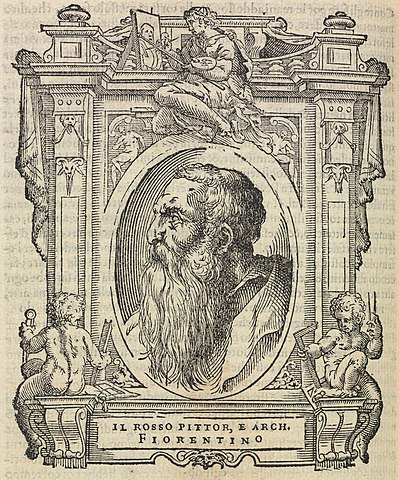
Born: 8 March 1494, Florence
Died: 14 November 1540 (aged 45)
Period: Mannerism
The Life of Rosso Fiorentino
Giovanni Battista di Jacopo, known as Rosso Fiorentino (meaning “Red Florentine” in Italian, a nickname referring to his red hair), was an Italian Mannerist painter born in Florence on March 8, 1494. As a prominent figure in the development of Mannerism, Rosso’s work is characterized by its expressive style, elongated forms, and often unsettling emotional intensity, marking a departure from the harmonious and idealized art of the High Renaissance.
Early Life and Education Rosso began his artistic training in Florence, where he was apprenticed under Andrea del Sarto, alongside another future Mannerist, Jacopo Pontormo. Under del Sarto’s guidance, Rosso developed a mastery of drawing and a keen sense of color, which would become hallmarks of his work. Despite the influence of his teacher, Rosso’s style diverged significantly, favoring dramatic compositions and a more personal, idiosyncratic approach to subject matter.
Artistic Development Rosso’s early works in Florence, including religious paintings and frescoes, already showed signs of his distinctive style, with exaggerated poses and a preference for stark contrasts of light and dark. His departure from the classical balance and proportion is often seen as a reaction against the dominant trends of his time, pushing towards a more expressive and individualistic art.
Move to France In 1530, after working in several Italian cities and facing various personal and professional challenges, Rosso moved to France, where he entered the service of King Francis I. This period marked the peak of his career. At the French court, he was involved in the decoration of the Château de Fontainebleau, becoming one of the first artists to introduce the Mannerist style to France. His work at Fontainebleau, particularly the Gallery of Francis I, is considered a masterpiece of Mannerist art, characterized by its innovative use of space, allegorical figures, and a complex iconographic program that blended classical mythology with royal imagery.
Legacy and Death Rosso Fiorentino’s career in France ended abruptly with his untimely death in 1540, under circumstances that remain unclear, with some accounts suggesting suicide. Despite his relatively short life, Rosso’s influence was profound, especially in the development of the Fontainebleau school of artists who expanded upon his Mannerist innovations.
Rosso Fiorentino’s work is noted for its emotional depth, technical skill, and pioneering approach to composition and color. His legacy is that of an artist who broke away from the norms of his time, creating a body of work that is both challenging and captivating, with an impact that extended beyond Italy to influence the course of French art and the broader Mannerist movement.
Rosso Fiorentino’s Notable Works
Rosso Fiorentino, a key figure in the early Mannerist movement, is celebrated for his unconventional approach to composition, vivid use of color, and the emotional intensity of his figures. His works, which often contain a sense of tension and dramatic expressiveness, have left a significant mark on the history of art. Here are ten of Rosso Fiorentino’s most famous works that exemplify his unique style:
- “Deposition from the Cross” (1521) – Located in the Pinacoteca Comunale, Volterra, this altarpiece is one of Rosso’s most acclaimed works, known for its dynamic composition and the poignant expression of grief.
- “Moses Defending the Daughters of Jethro” (c. 1523) – Housed in the Uffizi Gallery, Florence, this painting showcases Rosso’s talent for narrative and his innovative use of color and form.
- “Madonna Enthroned with Saints” (1518) – Also known as the “Pala Dei” altarpiece, located in the Basilica della Santissima Annunziata, Florence, it illustrates Rosso’s early mastery of religious themes.
- “The Holy Family with the Young Saint John the Baptist” (c. 1520) – A testament to his skill in portraying intimate, sacred moments with a deep emotional resonance.
- “Portrait of a Young Man” (c. 1520) – Housed in the National Gallery, London, this work exemplifies Rosso’s abilities in portraiture, capturing the subject’s character with sensitivity and depth.
- “Christ in Glory” (c. 1528) – Located in San Lorenzo, Florence, this fresco demonstrates Rosso’s skill in creating monumental compositions that are both innovative and impactful.
- “Gallery of Francis I” (c. 1534-1539) – Rosso’s work at the Château de Fontainebleau, particularly in the Gallery of Francis I, is considered a masterpiece of Mannerist interior design, featuring an intricate series of frescoes and stuccowork.
- “The Dead Christ with Angels” (c. 1524-1527) – This painting, now in the Museum of Fine Arts, Boston, is noted for its stark depiction of Christ’s body, surrounded by angels, reflecting Rosso’s interest in the theme of mortality.
- “Venus and Cupid with a Satyr” (c. 1524) – An example of Rosso’s mythological subjects, showcasing his ability to blend sensuality with a sophisticated allegorical context, now in the Louvre Museum.
- “Eleonora of Toledo” (c. 1539) – Though primarily known for his religious and mythological scenes, Rosso’s portraits, such as this one, believed to depict Eleonora of Toledo, highlight his nuanced approach to capturing the individuality of his subjects.
Rosso Fiorentino’s work is characterized by its innovative exploration of form, color, and emotional depth. His contributions to the Mannerist movement significantly influenced the course of European art, marking a departure from the ideals of the High Renaissance towards a more personal, expressive approach.